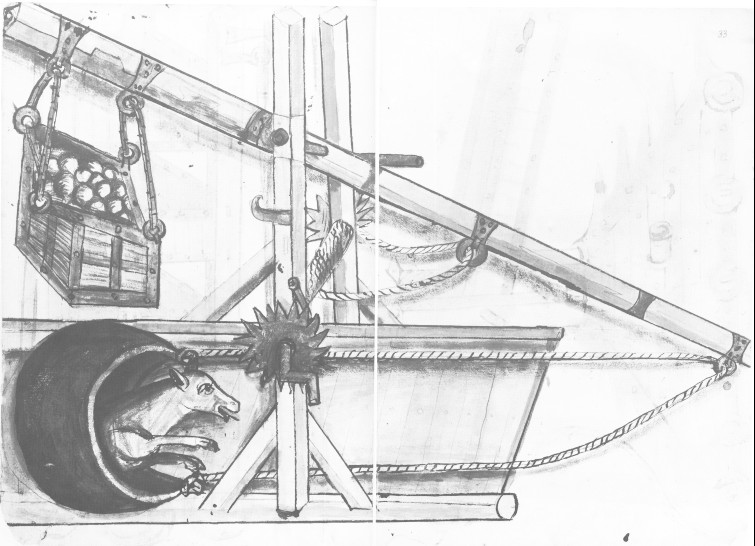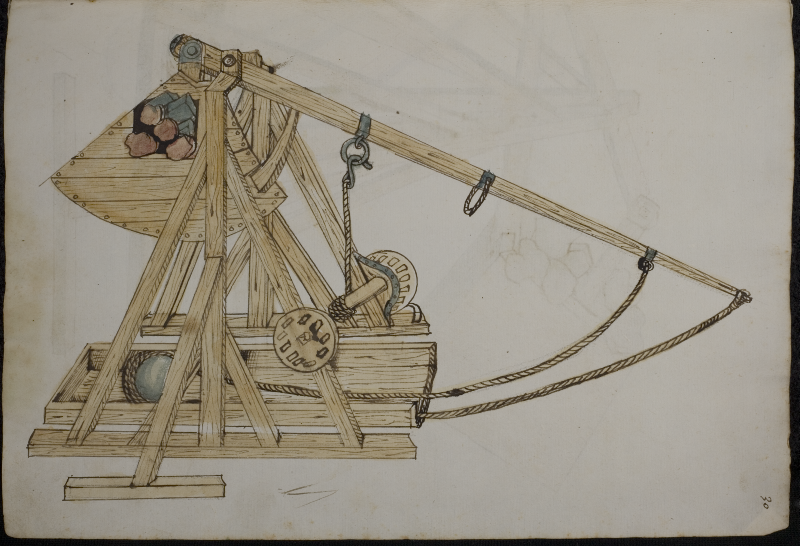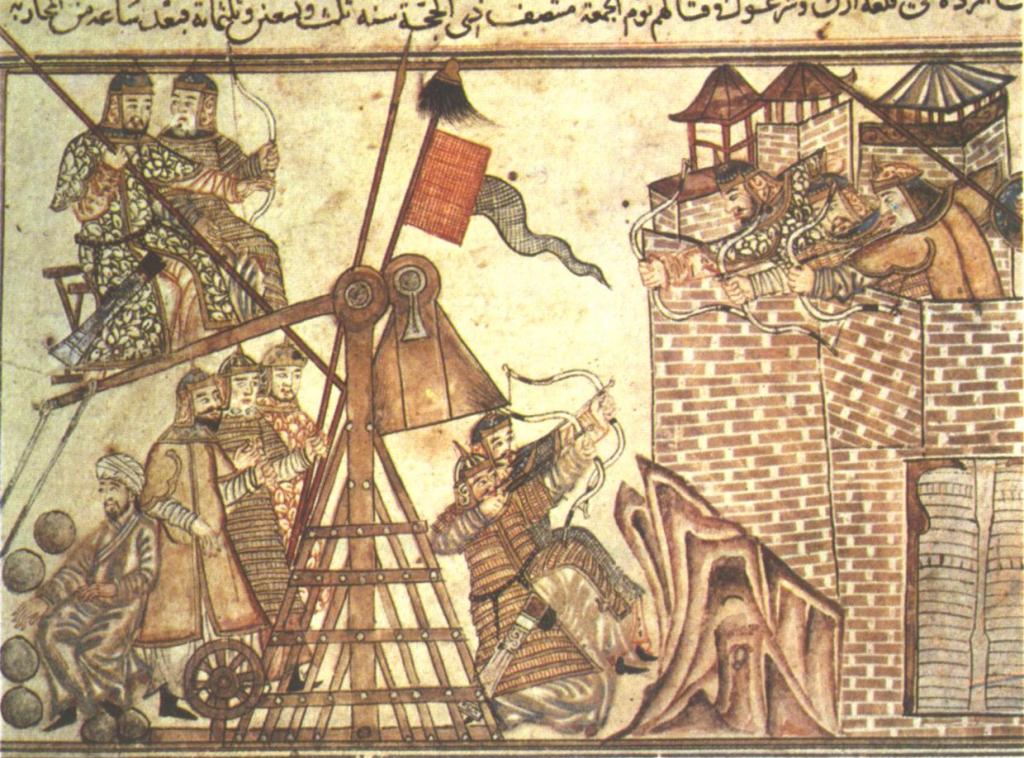Hi. I mentioned a while back that myself and a friend are Kickstarting a medieval weapons sound library. We've recently found a local farmer who has a small trebuchet that he throws pumpkins with. The spar is about fifteen feet long, with a box of around a thousand pounds. He does not have any sort of racheting system to span the engine, but uses a tractor and just has a helper set the pin when the spar is spanned back. We are planning on recording the loosing of the device, but would also like to get some sounds of a trebuchet being spanned. My question is: how were most of these smaller trebuchet spanned? I've seen large "mousewheels" on giant ones, and some racheting systems as well. What do you think is most historically common a device and could such a thing be built with any sort of relative ease? Thanks for any info you guys have!
Brian
The most historically accurate method would probably be ten or twelve sturdy men-at-arms.
Actually, a winch or a straight ratchet would probably be the best option. Either can be made of sturdy lumber, with or without metal reinforcements. The release is a little beyond my know-how for trebuchets, but you could extrapolate from the Legio XX ballista page: http://www.legionxxiv.org/ballista.htm.
Actually, a winch or a straight ratchet would probably be the best option. Either can be made of sturdy lumber, with or without metal reinforcements. The release is a little beyond my know-how for trebuchets, but you could extrapolate from the Legio XX ballista page: http://www.legionxxiv.org/ballista.htm.
At Nykøbing Falster's “Middelalder Center“ they have specialized in the building and researching of trebuchets and early cannons.
The museum leader Peter Vemming has lead it since 1992 and they have build both a small and a big trebuchet (Danish: Blide).
The big trebuchet used at Warwick Castle was build to his specifications (local carpenters and Danish ironfittings).
So the big one are “loaded“ by “mousewheels“ while the smaller ones are “loaded“ by muscle power as you can see in this clip (1.15-1.35 min): https://www.youtube.com/watch?v=iUMKJm5LLZY
Seeing them shot: https://www.youtube.com/watch?v=UhE_FxaUpfU&index=2&list=PLezwDWchAtcMFPUY7qcsW4fy5SjySJQPC
0.59-2.19 min
You can also see this article in Archaeology from 2005 about Peter Vemming about trebuchets:
http://archive.archaeology.org/online/interviews/vemming/
They had a conference and workshop called “Trebuchet to Cannon, Military Technology 1000-1600“ in 2010, but apparently the results haven't been published it. :\
From 2001 there has also been an ongoing study in early cannon and the making of early gunpowder. Apparently a sulphur mine in Iceland was in use for gunpowder production already in 1300 [it was processed as sulphur for gunpowder on the site].
If interested you can see some off the testing reports on the right of this web page (in english!):
http://www.middelaldercentret.dk/Projekter/krudtogkanoner.html
Parts of “The Mediaval Fightbook“ (about the Hans Talhoffer volume in the Copenhagen National Library) was shot at the “Middelalder Center“.
The museum leader Peter Vemming has lead it since 1992 and they have build both a small and a big trebuchet (Danish: Blide).
The big trebuchet used at Warwick Castle was build to his specifications (local carpenters and Danish ironfittings).
So the big one are “loaded“ by “mousewheels“ while the smaller ones are “loaded“ by muscle power as you can see in this clip (1.15-1.35 min): https://www.youtube.com/watch?v=iUMKJm5LLZY
Seeing them shot: https://www.youtube.com/watch?v=UhE_FxaUpfU&index=2&list=PLezwDWchAtcMFPUY7qcsW4fy5SjySJQPC
0.59-2.19 min
You can also see this article in Archaeology from 2005 about Peter Vemming about trebuchets:
http://archive.archaeology.org/online/interviews/vemming/
They had a conference and workshop called “Trebuchet to Cannon, Military Technology 1000-1600“ in 2010, but apparently the results haven't been published it. :\
From 2001 there has also been an ongoing study in early cannon and the making of early gunpowder. Apparently a sulphur mine in Iceland was in use for gunpowder production already in 1300 [it was processed as sulphur for gunpowder on the site].
If interested you can see some off the testing reports on the right of this web page (in english!):
http://www.middelaldercentret.dk/Projekter/krudtogkanoner.html
Parts of “The Mediaval Fightbook“ (about the Hans Talhoffer volume in the Copenhagen National Library) was shot at the “Middelalder Center“.
As far as I am aware, Almost universally, windlasses with ratchet were the most common and easy to produce mechanisms for spanning. Here some exapmles;
Anonymus of the Hussite Wars, 1475 (Ratchet mechanism clearly seen)

From Conrad Kyeser's Bellifortis;
[ Linked Image ]
Philip Mönch, 1496

Jami el Tevarih written between 1304-1314, Mongols besieging a castle;

[/img]
Anonymus of the Hussite Wars, 1475 (Ratchet mechanism clearly seen)

From Conrad Kyeser's Bellifortis;
[ Linked Image ]
Philip Mönch, 1496

Jami el Tevarih written between 1304-1314, Mongols besieging a castle;

[/img]
| Semih Koyuncu wrote: |
| As far as I am aware, Almost universally, windlasses with ratchet were the most common and easy to produce mechanisms for spanning. Here some exapmles; |
Very nice pictures and it's probably true that was done for most of the small trebuchets.
Sadly we don't have any well preserved archaeological finds of trebuchets.
As Peter Vemming states in the article I referred to above: “The only fully preserved machine was excavated under a church in 1890s at Liebemuehl in East Prussia, but shortly after excavation it was cut up for firewood“.
So it's always a question of how correct these depictions actually were. How many are made by men that actually knows how a war machine works? So it's for know still the best we have, but testing has to be done to see what works and what doesn't.
For most cases it is true that book copying monastic audience were unaware of what they are doing but this was not the case when it comes to specially prepared books written by expert military technicians such as Konrad Kyeser, Ibn Erenbugha or Al Tarsusi.
Also, if we try to get a solution in a scientific way, by taking statistics of visual evidences remaining we can conclude that windlass was the most popular spanning device. Interestingly, there are quite a few historical images of thread wheel mechanism. They were not that common as represented by popular media.
About written evidence such details are hard to obtain. Writers in most cases omitted about some details, maybe intentionally not to provide secrets of building such powerful weapons.
Also, if we try to get a solution in a scientific way, by taking statistics of visual evidences remaining we can conclude that windlass was the most popular spanning device. Interestingly, there are quite a few historical images of thread wheel mechanism. They were not that common as represented by popular media.
About written evidence such details are hard to obtain. Writers in most cases omitted about some details, maybe intentionally not to provide secrets of building such powerful weapons.
| Semih Koyuncu wrote: |
| For most cases it is true that book copying monastic audience were unaware of what they are doing but this was not the case when it comes to specially prepared books written by expert military technicians such as Konrad Kyeser, Ibn Erenbugha or Al Tarsusi.
Also, if we try to get a solution in a scientific way, by taking statistics of visual evidences remaining we can conclude that windlass was the most popular spanning device. Interestingly, there are quite a few historical images of thread wheel mechanism. They were not that common as represented by popular media. About written evidence such details are hard to obtain. Writers in most cases omitted about some details, maybe intentionally not to provide secrets of building such powerful weapons. |
Good point about military secret. By far most of the warfare in european middle ages were sieges and most sensible persons wouldn't risk a pitched battle and then risk losing in an afternoon what a family had build up over centuries. [“If he siege one of our castles we siege one of his - then eventually we both get trading baits"].
Still even with the books of military experts, they are hardly in any kind of scale you can build any copies from (perhaps it is deliberate?!). Special craftsmen were needed and also that has be learned the hard way today by trial and error.
The threadmill/mousewheel really makes sense for a siege, since beside being used for bigger trebuchets it also protects the people from bolts and arrows, while if you have to use a windlass you are much more exposed in the open.
| William Alexander Elder wrote: |
| The most historically accurate method would probably be ten or twelve sturdy men-at-arms. |
Probably not men-at-arms in most cases -- they'd be too prestigious to take part in such menial work. Mind that "men-at-arms," for the most part, referred to the people known to modern popular culture as "knights." A sizeable army, large enough to transport and assemble a trebuchet for a siege (or harvest materials and build it on the spot), would have had significant numbers of more expendable infantry and even more expendable civilian labourers to do the job.
Anyway, the smallest trebuchets were human-powered to begin with, so expect to hear wood creaking, metal squeaking, and men grunting.
http://www.youtube.com/watch?v=yAQdk4skmSE
http://members.iinet.net.au/~rmine/htt/ttspot.html
| Lafayette C Curtis wrote: |
| Probably not men-at-arms in most cases -- they'd be too prestigious to take part in such menial work. Mind that "men-at-arms," for the most part, referred to the people known to modern popular culture as "knights." A sizeable army, large enough to transport and assemble a trebuchet for a siege (or harvest materials and build it on the spot), would have had significant numbers of more expendable infantry and even more expendable civilian labourers to do the job. |
I agree. Since it was dangerous being within shooting range it would not have been done by valuable soldiers or craftsmen but rather grunts. Since pulling is grunt work it was likely civilians or at least expandable troops.
Page 1 of 1
You cannot post new topics in this forumYou cannot reply to topics in this forum
You cannot edit your posts in this forum
You cannot delete your posts in this forum
You cannot vote in polls in this forum
You cannot attach files in this forum
You can download files in this forum
All contents © Copyright 2003-2006 myArmoury.com — All rights reserved
Discussion forums powered by phpBB © The phpBB Group
Switch to the Full-featured Version of the forum
Discussion forums powered by phpBB © The phpBB Group
Switch to the Full-featured Version of the forum